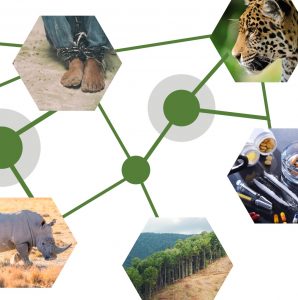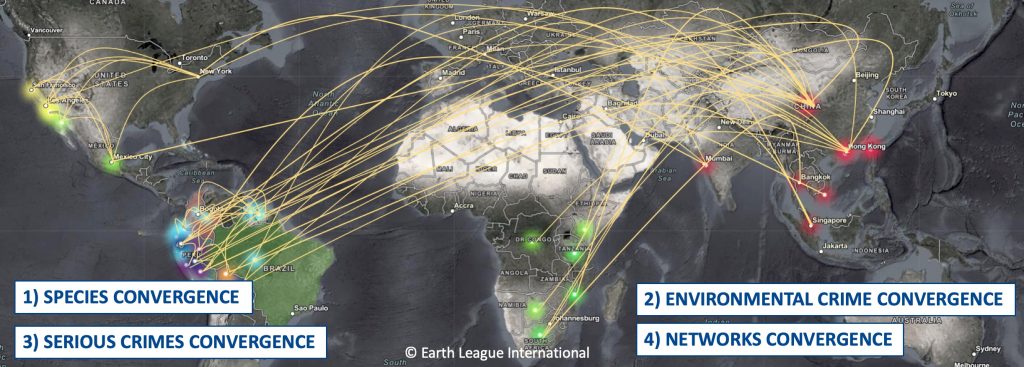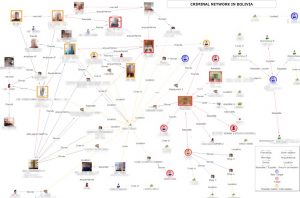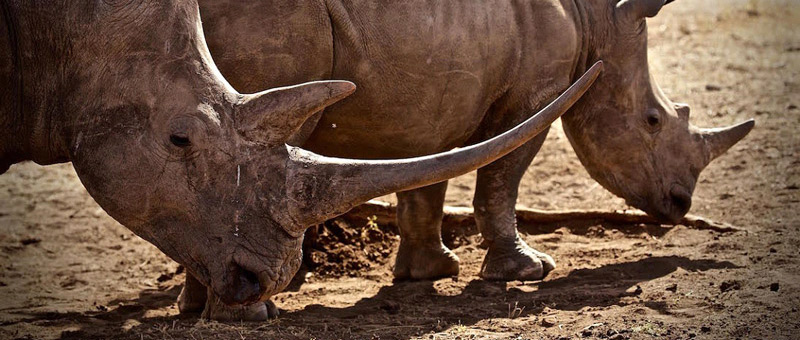THE IMPORTANCE OF CRIME CONVERGENCE IN TACKLING ENVIRONMENTAL/WILDLIFE CRIME
Understanding the Convergence of Environmental/Wildlife Crime with other Serious Crimes
Despite being widely recognized as one of the largest transnational organized crime industries worldwide, environmental crime has been primarily treated as an environmental/conservation issue, failing to be properly contextualized within the broader framework of crime convergence.
ELI has served as a pioneer in the use of professional intelligence and analysis to provide empirical evidence and information regarding environmental crime convergence. Read our ground-breaking report on Environmental Crime Convergence here.
WHAT IS CRIME CONVERGENCE?

Traditionally, the concept of crime convergence has been widely utilized by law enforcement and government authorities within the context of Transnational Organized Crime (TOC), in which self-perpetuating associations of individuals operate transnationally for the purpose of obtaining power, influence, and monetary gains, wholly or in part by illegal means (United States National Security Council, 2011). Convergence is recognized as a critical feature of TOC groups, which have expanded their criminal activities due to globalization, transnational commerce systems, advancements in technology, and the development of online money transfer systems (Miklaucic & Brewer, 2013).
Transnational criminal networks take advantage of globalization’s unprecedented openness to continually expand the size, scope, alliances, and diversity of their illicit activities. The adaptable and innovative nature of their work allows them to advance their illicit activities and mechanisms in unparalleled ways, and they have the financial and human resources to do so.
Environmental crime is reported to ‘converge,’ or overlap, with counterfeiting, drug trafficking, cybercrime, human trafficking, financial crime, arms trafficking, and terrorism. Environmental crime, often an easy source of money for organized crime, is a cross-cutting criminal activity; it converges alongside other serious crimes and augments the influence of existing transnational organized crime networks (INTERPOL 2016, UNODC, 2012).
Organized crime syndicates diversify into the lucrative business of tropical timber, endangered species, and natural minerals, alongside their traditional activities. The developing interconnectedness between environmental crime and other serious crimes shows that traditional lines of separation are no longer appropriate for understanding and dealing with the increasing complexities of organized crime (Daan P. van Uhm and Rick C.C. Nijman, 2020)
For years professionals like Dr. Rod Schoonover, fmr. U.S. Diplomat and national security expert David Luna,. Louise Shelley, Dr. Daan P. van Uhm and Dr. Odean Serrano were pioneers in researching Convergence and the nexus of environmental crimes with other serious crimes and global threats.
Yet, while the concept of convergence within “traditional” organized crime activities has long been established, a persistent and extensive gap regarding environmental crimes and its convergence with other serious crimes remains (OECD 2018; Nellemann et al., 2018).
ELI’s 4-TYPE ENVIRONMENTAL CRIME CONVERGENCE PARADIGM
Through our field work and based on information collected first-hand during our field operations on dozens of transnational wildlife trafficking networks and some of the most important environmental criminals in the world, ELI has defined, instituted, and analyzed a suite of “4 Environmental Crime Convergence “Types”:
- Multiple Species Convergence refers to international networks that traffic multiple species at the same time (eg: rhino horn, ivory, pangolin, jaguar and shark fins)
- Multiple Environmental Crime Convergence involves the same traffickers/networks engaging in wildlife crime plus other environmental crimes such as illegal logging, illegal mining, and illegal fishing.
- Serious Crime Convergence refers to the same traffickers/networks engaging in other serious crimes such as human smuggling, money laundering, corruption, and drug trafficking.
- Transnational Network Convergence describes the overlap of transnational organized criminal networks and their activities. Network convergence is multileveled, as these criminal networks have intentionally created a variety of regional, interregional, and transnational points of connection to strengthen their criminal activities.

WHY IS CONVERGENCE IMPORTANT IN THE FIGHT AGAINST ENVIRONMENTAL CRIME?
As incidences of crime convergence continue to expand at unprecedented rates, it is essential that we develop an evidence-based understanding of this concept and integrate these findings within efforts to address environmental crime and conserve the natural world. A lack of knowledge and information regarding crime convergence undermines efforts to protect wildlife, natural resources, ecosystems, and communities.
Furthermore, environmental crime’s cross-cutting nature yields important opportunities for law enforcement and government authorities to strategically fight organized crime at large. It is referred to as the “soft underbelly” of transnational criminal networks, serving as a gateway into the investigation of these networks and their involvement in other serious crimes.
In other words, we can arrest and charge top wildlife traffickers and environmental criminals for crimes that are more serious than wildlife crime.

HOW DOES ELI PROVIDE EVIDENCE OF ENVIRONMENTAL CRIME CONVERGENCE?
ELI’s operational work focuses on identifying and understanding convergence through an evidence-based approach that involves the acquisition of videos, audio, documents, financial information and other forms of data. Following our intelligence-gathering operations, ELI processes and analyze the data and evidence regarding the illegal supply chains, including identifying high-level wildlife traffickers, middlemen, corrupt public officials, and various Persons of Interests. We also identify patterns among our findings, seeking to address the information gap related to crime convergence.
In general, Convergence Analysis involves the understanding of the operations and modus operandi of international trafficking syndicates and Transnational Organized Crime (TOC) groups that profit from wildlife trafficking, natural resources, humans, narcotics, and the nexus to cartels and financial crimes.
We then disseminate this knowledge to relevant law enforcement and government authorities (through our Confidential Intelligence Briefs – CIBs). providing them with evidence related to convergence’s degree and scope. Using ELI’s actionable intelligence, these authorities can successfully investigate, charge and prosecute these criminals for multiple crimes. We further collaborate with these authorities, engaging in capacity building sessions and trainings to provide a nuanced understanding of how convergence presents in the field.

Earth League International (ELI) serves as a pioneer in the use of professional intelligence and analysis to illuminate and fill the intelligence gap related to transnational environmental/wildlife criminal networks and environmental crime convergence. We operate in the space of Environmental Crime Intelligence to identify and expose global environmental crime networks, and the intersections of their criminal activities.
We define and work on specific convergence themes in various combinations to address the understanding of the nexus between multiple species trade and trafficking (supply chain on a global scale), multiple environmental crimes (wildlife crime, illegal logging, mining, and fishing), the links to other serious crimes (human trafficking, money laundering, drugs, corruption, and the convergence of the respective organized criminal networks that carry out these crimes.
RECOMMENDATIONS
We recommend greater training for law enforcement to detect practices of organized crime, map out local networks, and identify hotspots of convergence. Amid the lack of training, prioritization, and material support for law enforcement authorities, environmental criminality has spread unencumbered.
Second, criminal justice officials must make convergence integral to criminal investigations. As documented by our field work, environmental crime is rarely committed in isolation and involves at least one type of convergence with other serious crimes. A focus on convergence widens the opportunities to detect and capture criminal leaders. Environmental crimes are extremely difficult to prosecute, and among the small minority that are, sanctions are rarely strong enough to be deterrents.
But, as in the case of Al Capone, evidence of other crimes – from money laundering to assassination – are more promising ways to catch them. Activists in Peru, for example, argue that most illegal gold mining syndicates can be most easily prosecuted for forced labor crimes.
Such proactive efforts to broaden systematic investigations and intelligence analysis will increase the likelihood of identifying and disrupting criminal networks.


